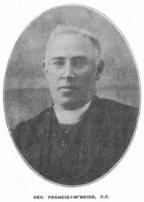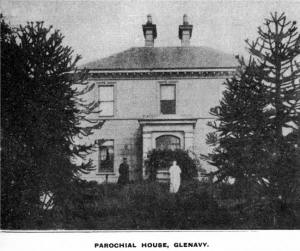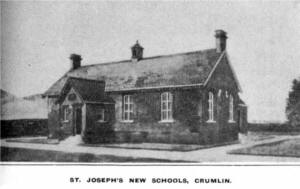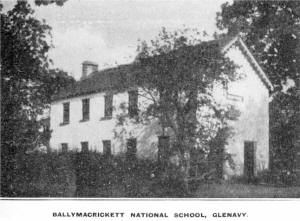III.-THE LAND OF THE OAKWOODS.
In ancient times Glenavy was extensively wooded. The names of so many places in and around the parish suggest this at once : Kilultagh (Cil Ultach) means the wood of the Ulstermen or men of Ulaidh ; Ballinderry is the townland of the oakwood; Feymore the great wood; Derrymore the great oakwood; Derryola the oakwood of Fola ; Derryclone the oak meadow ; Derryhirk the oakwood of the boar; Derrynaseer the oakwood of the tradesmen; Magheramesk the plain of acorns. That these woods still covered the country at the time of the Plantations is clear from various documents written at that time. In 1586 Sir Henry Bagenal, in his description of Ulster, says :-” Kilultoe is a very fast countrey full of wood and bogg; it bordereth upon Loghe Eaghe and Clanbrasell.” A note on the corner of an old map published about 1592 informs us that ” along this river (Lagan) be the space of 26 miles groweth much woodes as well as hokes (oaks) for tymber and hother woodde.”
Kilultagh (Cil Ultach) means the wood of the Ulstermen or men of Ulaidh ; Ballinderry is the townland of the oakwood; Feymore the great wood; Derrymore the great oakwood; Derryola the oakwood of Fola ; Derryclone the oak meadow ; Derryhirk the oakwood of the boar; Derrynaseer the oakwood of the tradesmen; Magheramesk the plain of acorns. That these woods still covered the country at the time of the Plantations is clear from various documents written at that time. In 1586 Sir Henry Bagenal, in his description of Ulster, says :-” Kilultoe is a very fast countrey full of wood and bogg; it bordereth upon Loghe Eaghe and Clanbrasell.” A note on the corner of an old map published about 1592 informs us that ” along this river (Lagan) be the space of 26 miles groweth much woodes as well as hokes (oaks) for tymber and hother woodde.”
IV. – THE CHURCH OF THE DWARF.
The First Church and the First Parish Priest.
 The ancient name of the Parish of Glenavy was Lann Abhaigh the Church of the Dwarf. The G was prefixed to the word at a comparatively recent date. In all English documents up to the seventeenth century the name is found in some such form as Lenavy, Lynavy, or Lennewy. The tradition is that when St. Patrick was preaching in the district, he made many converts, and left a church there under the care of his disciple, Donal the. Dwarf ,called also Patrick’s Angel, on account of his angelic purity. The site of the church founded by St. Patrick is said to be a little outside the village, at the angle where the Pigeontown Road meets the main road between Glenavy and Ballycessy. The Protestant church occupies a site that was used in Catholic times, but the ancient church was most probably on the opposite side of the Glenavy Road. St. Patrick, it would seem, had a lingering affection for the scenes where he spent six or seven years of his boyhood. The descendants of the Red Branch Knights could not have failed to retain at least some of their chivalry and natural virtues, and the boy-slave, in moving amongst them, must have noticed and admired many a noble trait and generous characteristic.
The ancient name of the Parish of Glenavy was Lann Abhaigh the Church of the Dwarf. The G was prefixed to the word at a comparatively recent date. In all English documents up to the seventeenth century the name is found in some such form as Lenavy, Lynavy, or Lennewy. The tradition is that when St. Patrick was preaching in the district, he made many converts, and left a church there under the care of his disciple, Donal the. Dwarf ,called also Patrick’s Angel, on account of his angelic purity. The site of the church founded by St. Patrick is said to be a little outside the village, at the angle where the Pigeontown Road meets the main road between Glenavy and Ballycessy. The Protestant church occupies a site that was used in Catholic times, but the ancient church was most probably on the opposite side of the Glenavy Road. St. Patrick, it would seem, had a lingering affection for the scenes where he spent six or seven years of his boyhood. The descendants of the Red Branch Knights could not have failed to retain at least some of their chivalry and natural virtues, and the boy-slave, in moving amongst them, must have noticed and admired many a noble trait and generous characteristic.
Certain it is, at all events, that Patrick spent a long time preaching amongst the people of North Antrim, and founded many churches in the neighbourhood of Slemish. He was proceeding south-wards on his mission of love along the eastern shore of Lough Neagh, and at his word the fierce inhabitants of Dalaradia were yielding to the gentle influence of the Gospel, when he encountered unexpected opposition. The pagan King of Uladh, Saron son of Caelbadh, treated Patrick with insult and contumely, and tried to prevent him from building a church in his territories. He seized the hand of the Saint to expel him from the place. ” but Patrick,” says the Tripartite Life, ” took Heaven and land from him ;” that is, he predicted that he would be excluded from Heaven when he died, and would even lose his land during his lifetime. The church was founded, and the place was called Lahair Padruic = Patrick’s Site), and sometimes Leitir Padruic = Patrick’s Slope). Afterwards the church and parish came to be known as Lann Abhaigh in memory of the saint who was left by St. Patrick as the first parish priest of the place, and who laboured and died there, and was buried amongst his people. Thus does the name Glenavy bring us back to the days when our National Apostle was planting the Faith amongst the Pagan inhabitants of Dalaradia.
founded many churches in the neighbourhood of Slemish. He was proceeding south-wards on his mission of love along the eastern shore of Lough Neagh, and at his word the fierce inhabitants of Dalaradia were yielding to the gentle influence of the Gospel, when he encountered unexpected opposition. The pagan King of Uladh, Saron son of Caelbadh, treated Patrick with insult and contumely, and tried to prevent him from building a church in his territories. He seized the hand of the Saint to expel him from the place. ” but Patrick,” says the Tripartite Life, ” took Heaven and land from him ;” that is, he predicted that he would be excluded from Heaven when he died, and would even lose his land during his lifetime. The church was founded, and the place was called Lahair Padruic = Patrick’s Site), and sometimes Leitir Padruic = Patrick’s Slope). Afterwards the church and parish came to be known as Lann Abhaigh in memory of the saint who was left by St. Patrick as the first parish priest of the place, and who laboured and died there, and was buried amongst his people. Thus does the name Glenavy bring us back to the days when our National Apostle was planting the Faith amongst the Pagan inhabitants of Dalaradia.
![]()
Other saints of Glenavy.
We find other saints on the Irish Calendar in connection with the Parish of Glenavy. The Martyrology of Donegal commemorates, on November 6, ” Aedhan son of Colgan, of Lann Abhaigh, in Ulaidh.” The Fetére of Angus commemorates, on the 22nd January, the daughters of Comhghall ( Comgall), and adds : ” At Leitir, in Dalaradia, they are buried, and from Dalaradia they are sprung.” The Martyrology of Donegal has at the same date : ” Colman, Bogha, and Laisrc, three sisters and three virgins, of the sept of Comhghall, and they were disciples of Comhghall of Bangor, and they are interred at Leitir, in Dalaradia, according to the poem beginning : ` The Hagiology of the Saints of Inis-Fail.’ ” We may take it for certain that the reference is to Leitir Padruic, or Glenavy. It is to be feared that we could not write in our day what Father John Colgan, the historian, wrote in the middle of the seventeenth century : ” At Leitir these saints are worshipped.” There is no escape from the truth that these saints are no longer remembered amongst the hills and valleys where they once prayed and laboured for the salvation of souls ! With the loss of our native language, we have lost also the traditions it enshrined. We have almost forgotten that it was St. Patrick himself who first preached the Gospel in these parts, and that his labours in the district were fruitful in saintly lives.
November 6, ” Aedhan son of Colgan, of Lann Abhaigh, in Ulaidh.” The Fetére of Angus commemorates, on the 22nd January, the daughters of Comhghall ( Comgall), and adds : ” At Leitir, in Dalaradia, they are buried, and from Dalaradia they are sprung.” The Martyrology of Donegal has at the same date : ” Colman, Bogha, and Laisrc, three sisters and three virgins, of the sept of Comhghall, and they were disciples of Comhghall of Bangor, and they are interred at Leitir, in Dalaradia, according to the poem beginning : ` The Hagiology of the Saints of Inis-Fail.’ ” We may take it for certain that the reference is to Leitir Padruic, or Glenavy. It is to be feared that we could not write in our day what Father John Colgan, the historian, wrote in the middle of the seventeenth century : ” At Leitir these saints are worshipped.” There is no escape from the truth that these saints are no longer remembered amongst the hills and valleys where they once prayed and laboured for the salvation of souls ! With the loss of our native language, we have lost also the traditions it enshrined. We have almost forgotten that it was St. Patrick himself who first preached the Gospel in these parts, and that his labours in the district were fruitful in saintly lives.
The Native Tongue is shrinking from the race that gave it birth,
Like the tide receding from the shore, or the spring-time front the earth ;
From the island dimly fading, like a circle o’er the wave –
Receding as its people lisp the language of the slave ;
And with it, too, seem fading – as sunset into night –
All the scattered rays of glory that lingered in its light !